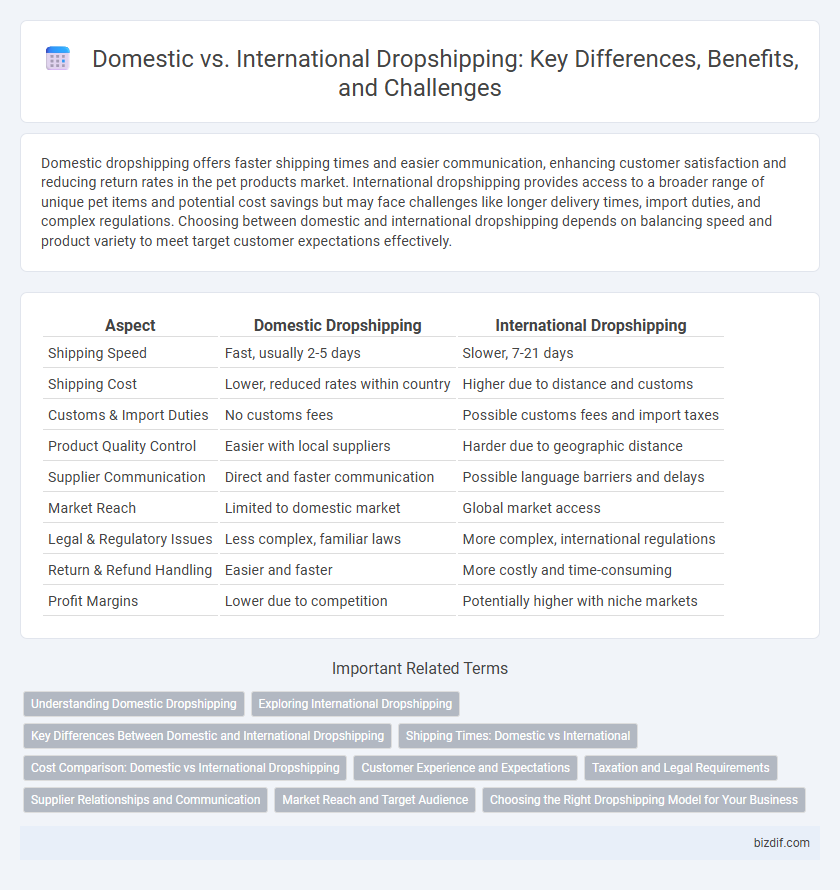Domestic dropshipping offers faster shipping times and easier communication, enhancing customer satisfaction and reducing return rates in the pet products market. International dropshipping provides access to a broader range of unique pet items and potential cost savings but may face challenges like longer delivery times, import duties, and complex regulations. Choosing between domestic and international dropshipping depends on balancing speed and product variety to meet target customer expectations effectively.
Table of Comparison
| Aspect | Domestic Dropshipping | International Dropshipping |
|---|---|---|
| Shipping Speed | Fast, usually 2-5 days | Slower, 7-21 days |
| Shipping Cost | Lower, reduced rates within country | Higher due to distance and customs |
| Customs & Import Duties | No customs fees | Possible customs fees and import taxes |
| Product Quality Control | Easier with local suppliers | Harder due to geographic distance |
| Supplier Communication | Direct and faster communication | Possible language barriers and delays |
| Market Reach | Limited to domestic market | Global market access |
| Legal & Regulatory Issues | Less complex, familiar laws | More complex, international regulations |
| Return & Refund Handling | Easier and faster | More costly and time-consuming |
| Profit Margins | Lower due to competition | Potentially higher with niche markets |
Understanding Domestic Dropshipping
Domestic dropshipping involves sourcing products from suppliers within the same country as the target market, enabling faster shipping times and easier handling of returns and customer service. This model reduces risks related to customs, import taxes, and international shipping delays, ensuring a smoother and more reliable fulfillment process. Businesses focusing on domestic dropshipping benefit from improved customer satisfaction due to quicker delivery and closer communication with suppliers.
Exploring International Dropshipping
International dropshipping expands market reach by allowing sellers to access diverse global customer bases and capitalize on varying demand trends. Managing international logistics involves navigating customs regulations, shipping costs, and longer delivery times, requiring robust supplier partnerships and reliable tracking systems. Leveraging localized marketing strategies and regional payment options enhances customer experience and drives higher conversion rates in multiple countries.
Key Differences Between Domestic and International Dropshipping
Domestic dropshipping typically offers faster shipping times and lower shipping costs compared to international dropshipping, which faces longer delivery periods and higher logistics expenses. International dropshipping involves navigating complex customs regulations, import taxes, and varying legal requirements across countries, while domestic dropshipping operates within a single regulatory environment. Moreover, domestic dropshipping often provides better customer service control and easier returns, whereas international dropshipping can encounter language barriers and currency exchange challenges.
Shipping Times: Domestic vs International
Domestic dropshipping offers significantly faster shipping times, often ranging from 2 to 5 business days, enhancing customer satisfaction with prompt delivery. International dropshipping usually involves extended transit periods, sometimes exceeding 14 days, due to customs processing and longer shipping routes. Efficient logistics and supplier location are critical factors influencing delivery speed in both domestic and international dropshipping models.
Cost Comparison: Domestic vs International Dropshipping
Domestic dropshipping typically incurs lower shipping costs and faster delivery times, reducing overall operational expenses and improving customer satisfaction. International dropshipping often involves higher shipping fees, customs duties, and longer transit times, which can increase total costs and affect profit margins. Choosing domestic suppliers minimizes hidden expenses and streamlines logistics, making it a more cost-effective option for many dropshipping businesses.
Customer Experience and Expectations
Domestic dropshipping offers faster shipping times and easier returns, enhancing customer satisfaction and trust. International dropshipping often faces longer delivery times, customs delays, and higher shipping costs, which can negatively impact customer expectations. Managing transparent communication and accurate tracking is crucial to maintaining a positive customer experience across both models.
Taxation and Legal Requirements
Domestic dropshipping simplifies tax compliance by limiting sales tax collection to one jurisdiction, reducing complexity associated with nexus laws and state-specific regulations. International dropshipping involves navigating varied VAT systems, import/export duties, and customs regulations, requiring thorough understanding of bilateral trade agreements and compliance with each country's tax codes. Legal requirements for international sellers often include obtaining business licenses, adhering to consumer protection laws, and managing cross-border contractual obligations.
Supplier Relationships and Communication
Domestic dropshipping offers stronger supplier relationships through easier communication channels such as phone calls and local meetings, reducing language barriers and time zone challenges. International dropshipping often involves complex coordination due to varying communication styles, longer response times, and potential misunderstandings with overseas suppliers. Building trust and maintaining consistent communication is crucial in both models but is generally more straightforward with domestic suppliers.
Market Reach and Target Audience
Domestic dropshipping limits market reach to a specific country, enabling focused targeting of local customer preferences, faster shipping times, and simplified logistics. International dropshipping expands market reach globally, targeting diverse audiences across multiple regions, but involves complex customs regulations, longer delivery times, and variable shipping costs. Choosing between domestic and international dropshipping depends on balancing the desired market expansion against operational challenges and customer service expectations.
Choosing the Right Dropshipping Model for Your Business
Choosing the right dropshipping model requires evaluating factors such as shipping speed, customs regulations, and target market preferences. Domestic dropshipping offers faster delivery and easier returns, enhancing customer satisfaction, while international dropshipping provides access to a broader market and potentially higher profit margins. Balancing logistics costs and scalability is essential for optimizing your dropshipping business success.
Domestic Dropshipping vs International Dropshipping Infographic

 bizdif.com
bizdif.com